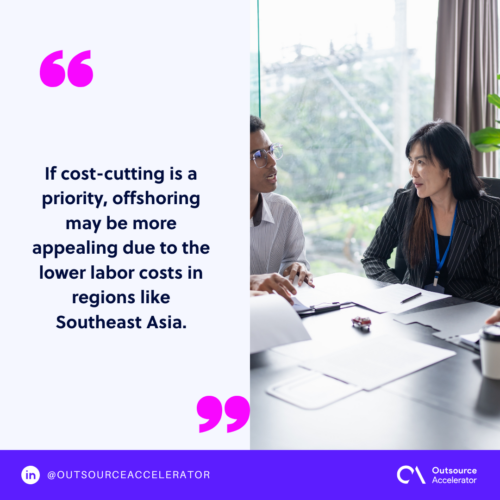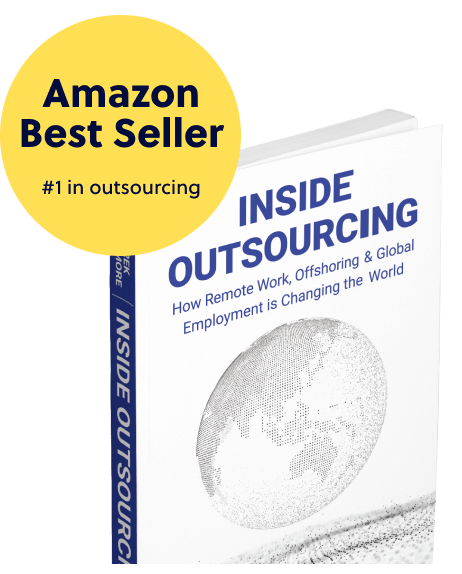Offshoring vs. Nearshoring: Your quick guide for scalable growth

As businesses grow, one of the biggest challenges is filling in-house positions with skilled talent. This issue becomes even more pressing in countries facing a significant skill gap, such as the United States.
According to a 2023 report by CompTIA, over 450,000 jobs in the technology sector in the country remain unfilled due to a lack of skilled workers.
The demand for specialized skills in fields like software development, cybersecurity, and data science has left companies scrambling to meet their needs. With limited local talent and rising recruitment costs, firms are increasingly turning to outsourcing to bridge the gap.
However, outsourcing isn’t the only option.
In the debate of offshoring vs. nearshoring, businesses have more flexible and strategic choices. While offshoring can offer cost savings by tapping into low-wage markets, nearshoring brings the benefits of geographic proximity, cultural alignment, and quicker communication.
In this article, we will explore the differences between offshoring and nearshoring, helping you decide which approach best supports your company’s scalable growth.
Whether you’re seeking efficiency or better collaboration, having a deeper knowledge of these strategies can unlock better opportunities for your organization.
Offshoring vs. Nearshoring: Understanding their key differences
When deciding where to outsource specific parts of daily operations or talent, businesses often face the choice between offshoring and nearshoring. While both strategies involve outsourcing work to external locations, they differ in terms of geography, costs, and operational dynamics.

Here’s a quick comparison of offshoring vs. nearshoring:
| Factor | Offshoring | Nearshoring |
| Geographic location | Outsourcing to distant countries, often in Asia, Africa, or Eastern Europe | Outsourcing to nearby or neighboring countries, typically within the same region |
| Cost efficiency | Often provides the lowest labor costs, especially in developing countries | Higher costs compared to offshoring but still more affordable than local hiring |
| Cultural alignment | Greater cultural differences, leading to potential communication barriers | Closer cultural similarities, making collaboration smoother |
| Time zone differences | Significant time zone gaps, which can lead to delayed communication | Smaller time zone differences, allowing for more overlap and real-time communication |
| Quality control | Can be harder to manage due to distance and language barriers | Easier to manage with closer proximity, which improves oversight and quality control |
| Speed of communication | Slower due to time zone gaps and language barriers | Faster due to proximity and shared languages or similar working hours |
In the offshoring vs. nearshoring debate, growing firms must weigh these factors to determine which strategy best fits their needs for cost, communication, and quality.
Each model offers unique features, but choosing the right approach depends on your company’s priorities for long-term scalability.
Offshoring vs. Nearshoring: How each approach supports businesses
Both offshoring and nearshoring offer unique advantages that can support a business’s growth, but each approach has its strengths depending on the company’s priorities.
Understanding how each method supports business needs can help you choose the best model for your specific goals:
| Support Factor | Offshoring | Nearshoring |
| Cost efficiency | Provides the most cost-effective option, especially in regions with low labor costs, like Southeast Asia. | More affordable than local hiring but at a higher cost than offshoring, especially in neighboring regions. |
| Talent access | Taps into a vast talent pool, particularly for technical roles, where highly skilled workers are abundant. | Access to skilled workers with similar expertise, though the talent pool might be smaller compared to offshoring. |
| Scalability | Highly scalable due to the lower cost of labor, making it ideal for companies looking to expand rapidly without significant overhead. | Scalable, though growth might be slower due to higher operational costs compared to offshoring. |
| Cultural and language fit | Larger cultural differences may lead to communication challenges, affecting collaboration. | Better alignment in terms of language and culture, resulting in smoother collaboration and fewer misunderstandings. |
| Operational flexibility | May face operational delays or slower response times due to time zone differences. | Closer time zones allow for quicker turnarounds and real-time collaboration, making it easier to adjust operations. |
| Regulatory compliance | May require additional oversight due to differences in regulations and compliance standards. | Easier to maintain compliance due to similar legal frameworks and regulations within neighboring countries. |
In the offshoring vs. nearshoring discussion, organizations must evaluate their priorities (whether it’s cost, speed, or cultural fit) before deciding which model best suits their needs for growth and efficiency.
Offshoring vs. Nearshoring: Which option is well-suited for your growing business?
Choosing between offshoring and nearshoring can significantly impact your business. While both options offer benefits, the best choice depends on your company’s specific needs.
Listed below are the primary considerations when deciding:
- Budget constraints. If cost-cutting is a priority, offshoring may be more appealing due to the lower labor costs in regions like Southeast Asia.

- Proximity and communication. If real-time collaboration and cultural alignment are vital, nearshoring offers closer time zones and fewer language barriers.
- Regulatory and legal compliance. Nearshoring is often more manageable due to similar legal frameworks, reducing the complexity of compliance.
- Talent availability. Offshoring might provide access to a broader talent pool, especially for specialized or tech-heavy roles.
In conclusion, if your business values cost savings and scalability over proximity, offshoring is ideal. However, if you prioritize seamless communication and cultural fit, nearshoring could be a better option for growth.







 Independent
Independent




